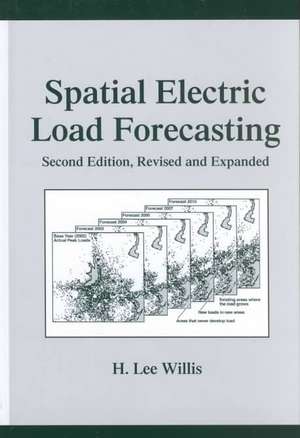Spatial Electric Load Forecasting: Power Engineering (Willis)
Autor H. Lee Willisen Limba Engleză Hardback – 9 aug 2002
Preț: 1949.66 lei
Preț vechi: 2377.64 lei
-18% Nou
Puncte Express: 2924
Preț estimativ în valută:
373.05€ • 389.54$ • 308.06£
373.05€ • 389.54$ • 308.06£
Carte tipărită la comandă
Livrare economică 15-29 aprilie
Preluare comenzi: 021 569.72.76
Specificații
ISBN-13: 9780824708405
ISBN-10: 0824708407
Pagini: 766
Dimensiuni: 152 x 229 x 39 mm
Greutate: 1.13 kg
Ediția:Revizuită
Editura: CRC Press
Colecția CRC Press
Seria Power Engineering (Willis)
ISBN-10: 0824708407
Pagini: 766
Dimensiuni: 152 x 229 x 39 mm
Greutate: 1.13 kg
Ediția:Revizuită
Editura: CRC Press
Colecția CRC Press
Seria Power Engineering (Willis)
Public țintă
ProfessionalNotă biografică
H Lee Willis (Quanta Technology, Cary, North Carolina, USA) (Author)
Cuprins
Spatial Electric Load Forecasting Consumer Demand for Power and ReliabilityCoincidence and Load BehaviorLoad Curve and End-Use ModelingWeather and Electric LoadWeather Design Criteria and Forecast NormalizationSpatial Load Growth BehaviorSpatial Forecast Accuracy and Error MeasuresTrending MethodsSimulation Method: Basic ConceptsA Detailed Look at the Simulation MethodBasics of Computerized SimulationAnalytical Building Blocks for Spatial SimulationAdvanced Elements of Computerized SimulationHybrid Trending-Simulation MethodsAdvanced Demand Methods: Multi-Fuel and Reliability ModelsComparison and Selection of Spatial Forecast MethodsDevelopment Dimensionality: Urban, Rural and Agrarian AreasMetropolitan Growth and Urban RedevelopmentSpatial Load Forecasting in Developing EconomiesUsing Spatial Forecasting Methods WellRecommendations and GuidelinesIndex
Descriere
Containing 12 new chapters, this second edition offers increased coverage of weather correction and normalization of forecasts, anticipation of redevelopment, determining the validity of announced developments, and minimizing risk from over- or under-planning. It provides specific examples and detailed explanations of key points to consider for both standard and unusual utility forecasting situations, information on new algorithms and concepts in forecasting, a review of forecasting pitfalls and mistakes, case studies depicting challenging forecast environments, and load models illustrating various types of demand.





























